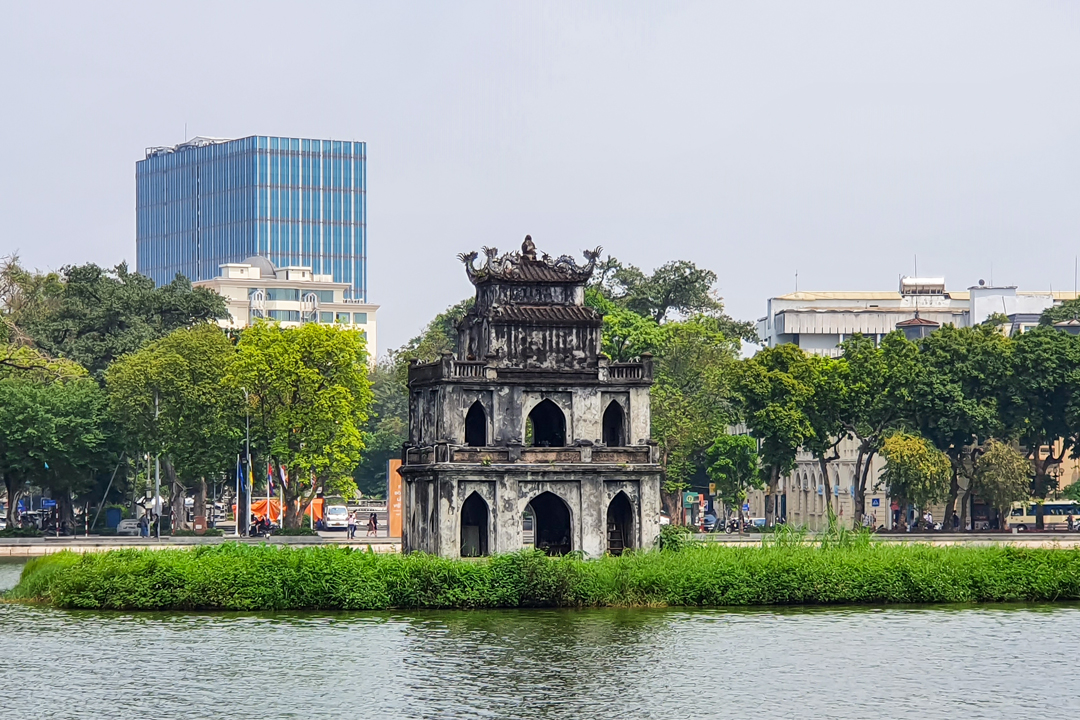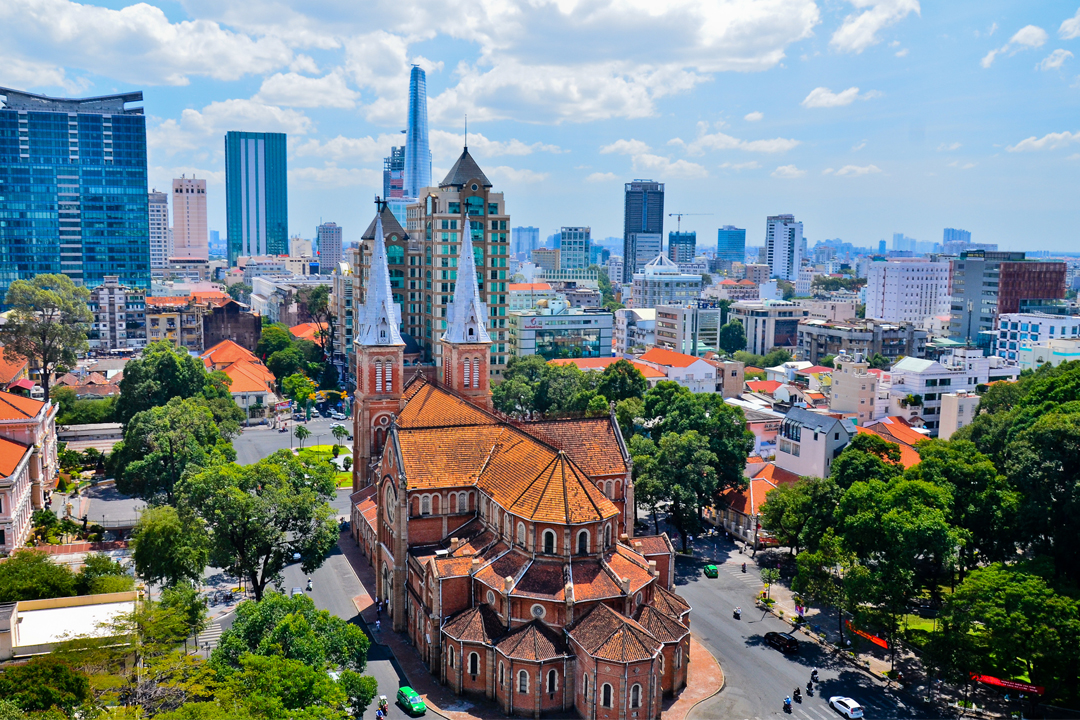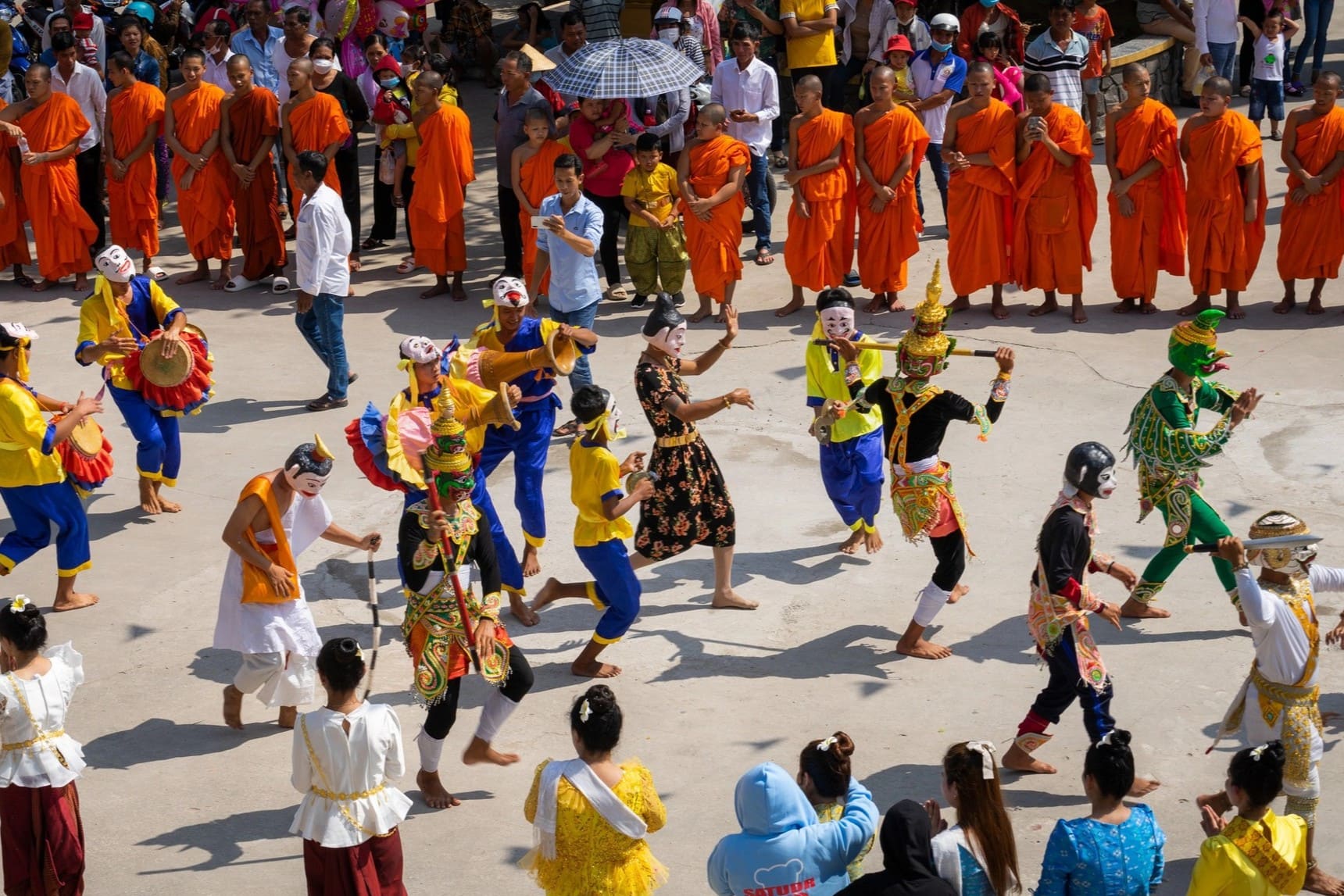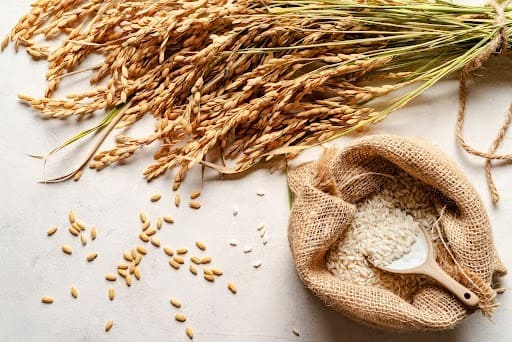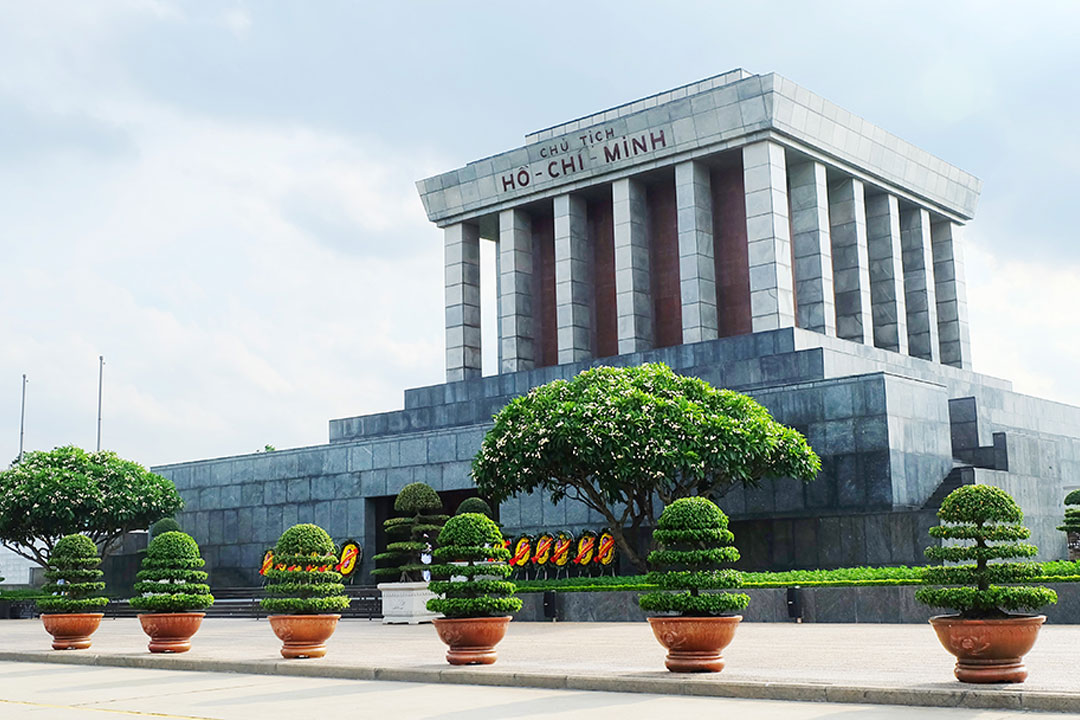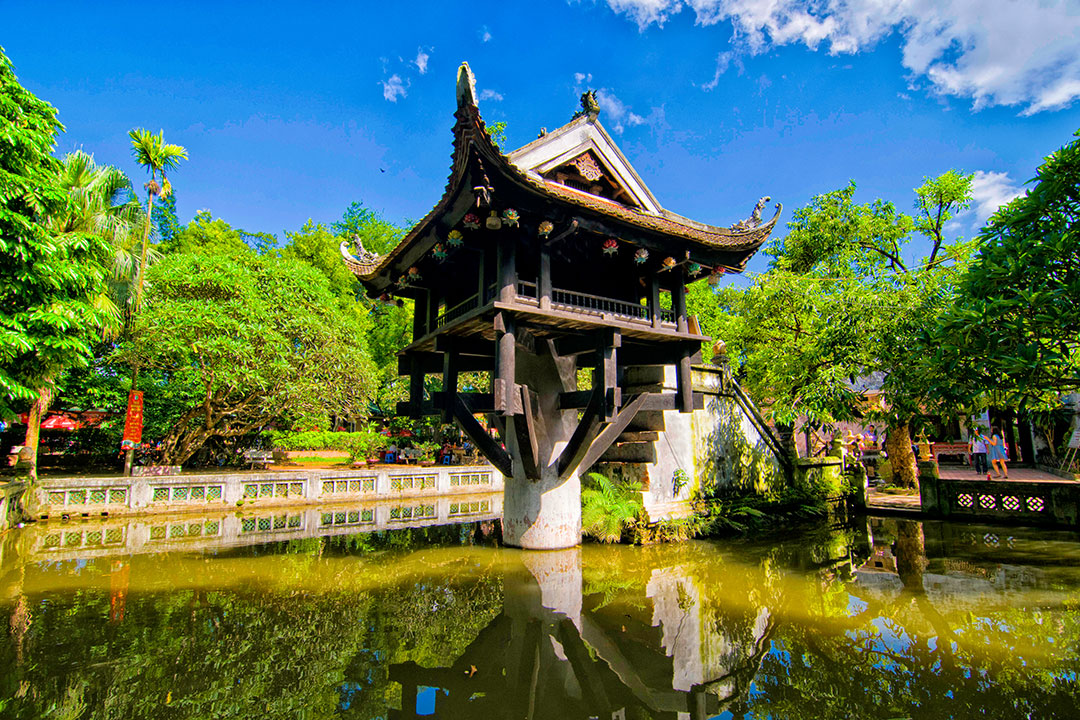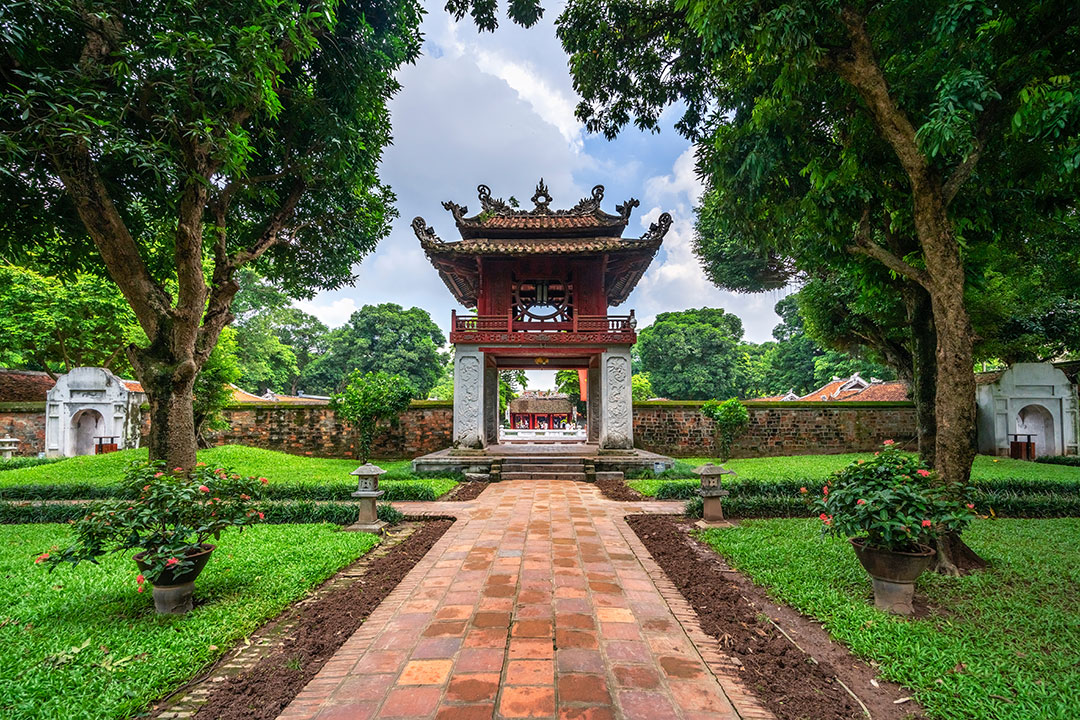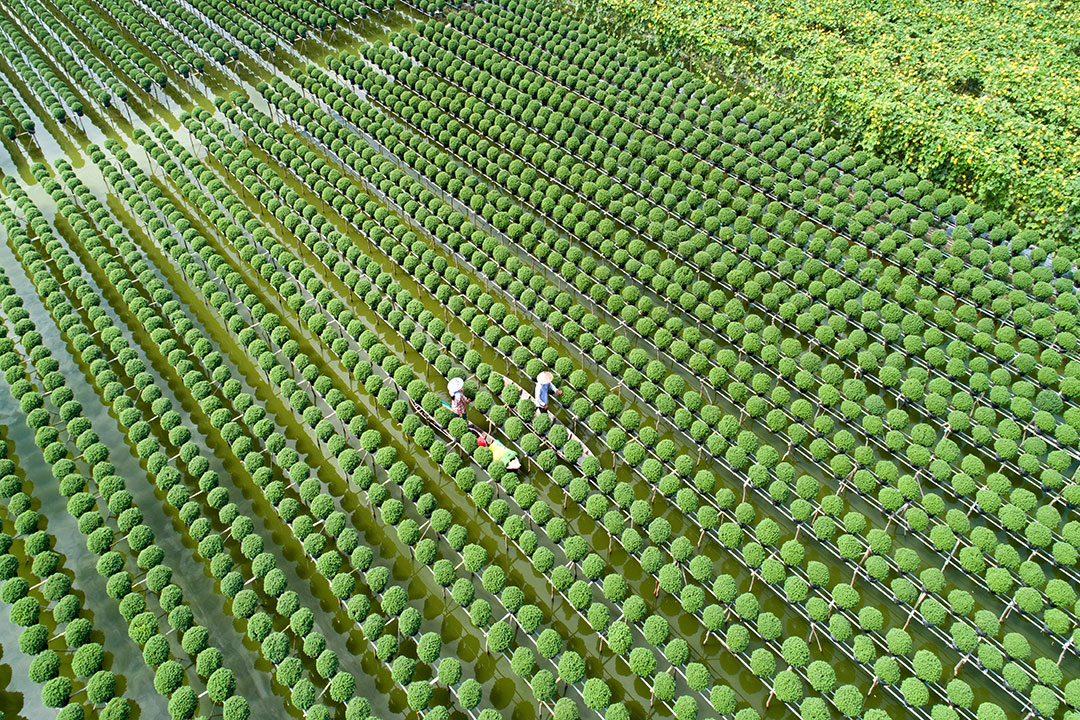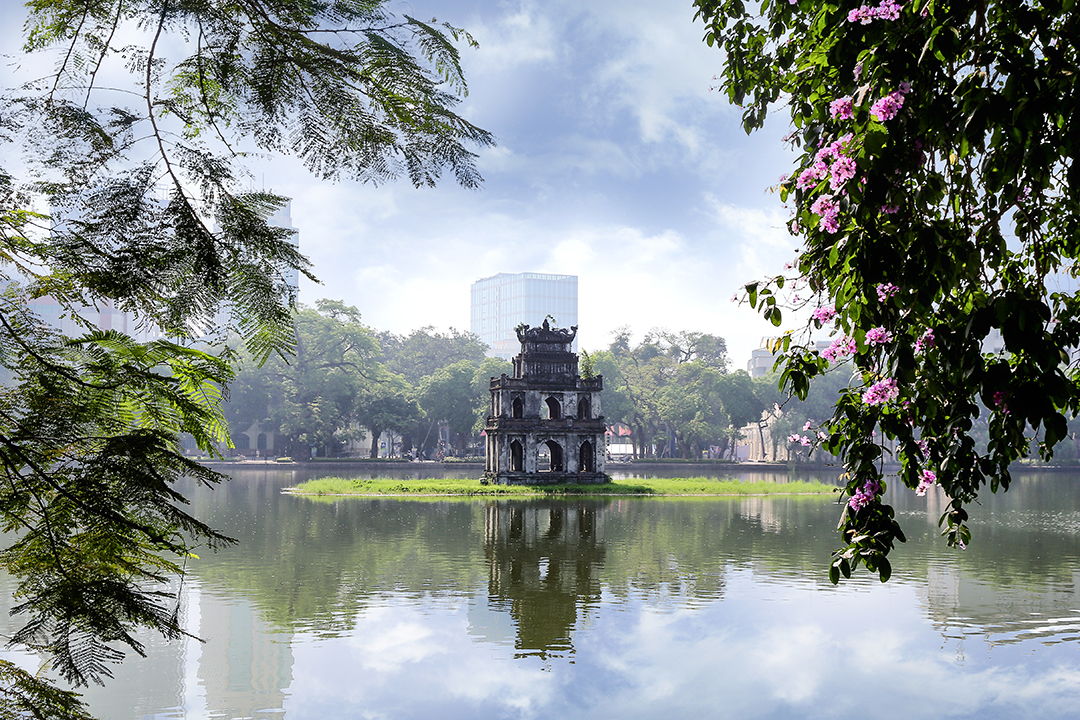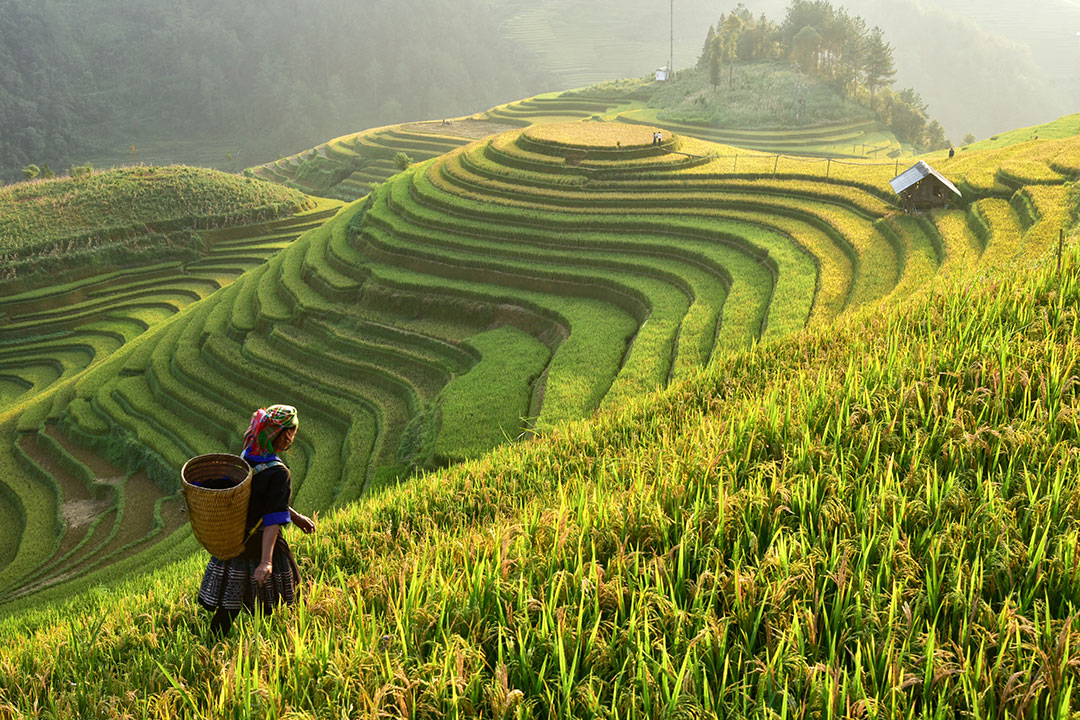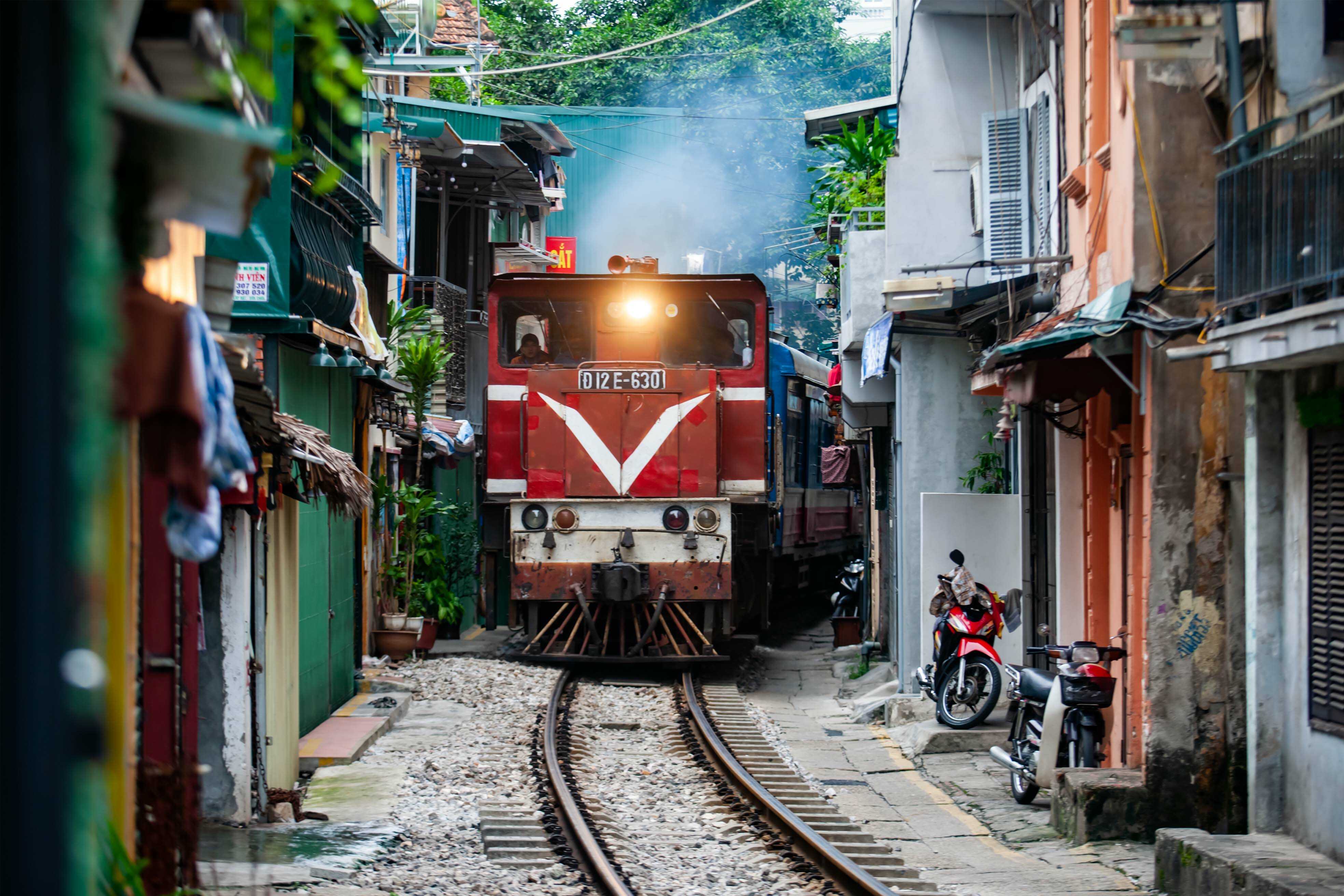Tay Ho Temple (Phu Tay Ho): Location, Worshiped Persons, Things To Do & Travel Guide
Tay Ho Temple (Phu Tay Ho) stands as a serene testament to Vietnam’s rich tapestry of history, culture, and spiritual tradition. This age-old temple, nestled on the banks of West Lake in Hanoi, offers a glimpse into ancient Vietnamese spiritual practices and invites you to immerse yourself in an atmosphere imbued with mysticism and tranquility. The allure of Tay Ho Temple extends beyond its religious significance. It serves as a mesmerizing getaway from the bustling city life, where historical legacies meet natural beauty. For those seeking cultural enrichment or solace amidst architectural magnificence, this sanctuary appeals deeply to both devout believers and curious travelers alike. As you prepare to uncover its hidden stories and sacred rituals, join us through GTrip’s exploration that promises insights into what makes Phu Tay Ho an essential chapter in Vietnam's vast narrative.
Introduction to Tay Ho Temple
Tay Ho Temple, commonly known as Phu Tay Ho, stands as one of Hanoi's most revered spiritual landmarks. This sacred complex draws both devout worshippers and curious travelers seeking to understand Vietnam's rich tapestry of indigenous beliefs. Nestled along the serene shores of West Lake, the temple complex represents the perfect fusion of natural beauty and cultural significance.
Where is Tay Ho Temple?
Location: 52 Dang Thai Mai Street, Tay Ho Ward (52 Dang Thai Mai Street, Quang An Ward, Tay Ho District, Hanoi)
The temple occupies a picturesque peninsula that extends into West Lake, Hanoi's largest freshwater lake. This exceptional location provides visitors with breathtaking views of the surrounding waters and lush landscapes. The peninsula setting creates a sense of serenity and separation from Hanoi's bustling urban centers. Many locals believe this unique geographic position between land and water enhances the temple's spiritual power. The temple's waterfront location also makes it particularly appealing during sunrise and sunset, when golden light bathes the traditional architecture.
Recognized as one of the most sacred temples in Hanoi, Phu Tay Ho serves as the primary worship center dedicated to the Mother Goddess religion. Its placement on the tranquil shores of West Lake creates a peaceful atmosphere conducive to spiritual reflection. The surrounding neighborhood of Tay Ho has developed into an expatriate enclave while still maintaining much of its traditional Vietnamese character. Despite being just a short distance from central Hanoi, the temple area feels worlds away from the capital's noise and congestion.
Who is worshiped at Tay Ho Palace?
Mother Goddess Lieu Hanh, also known as Princess Quynh Hoa, holds the position of primary deity at Tay Ho Temple. According to Vietnamese folklore, she is the daughter of the Jade Emperor who descended to Earth to experience human life. Lieu Hanh stands as one of Vietnam's four immortal saints alongside Son Tinh (Mountain God), Thanh Giong (Saint Giong), and Chu Dong Tu. Her significance extends beyond mere mythology as she represents divine feminine energy and compassion in Vietnamese traditional beliefs.
The temple complex honors the Three Mother Goddesses, central to Vietnam's indigenous faith system. Mother Lieu Hanh (Mau De Nhat Thuong Thien) reigns as the supreme celestial deity at the temple. Mother Thuong Ngan, represented by the color green, governs the mountains and forests. Mother Thoai, associated with white, rules over the waters and brings prosperity. Together, these three goddesses embody the natural elements believers seek protection from and blessings for. This trinity reflects Vietnam's ancient animistic traditions that recognize divine feminine presence throughout the natural world.
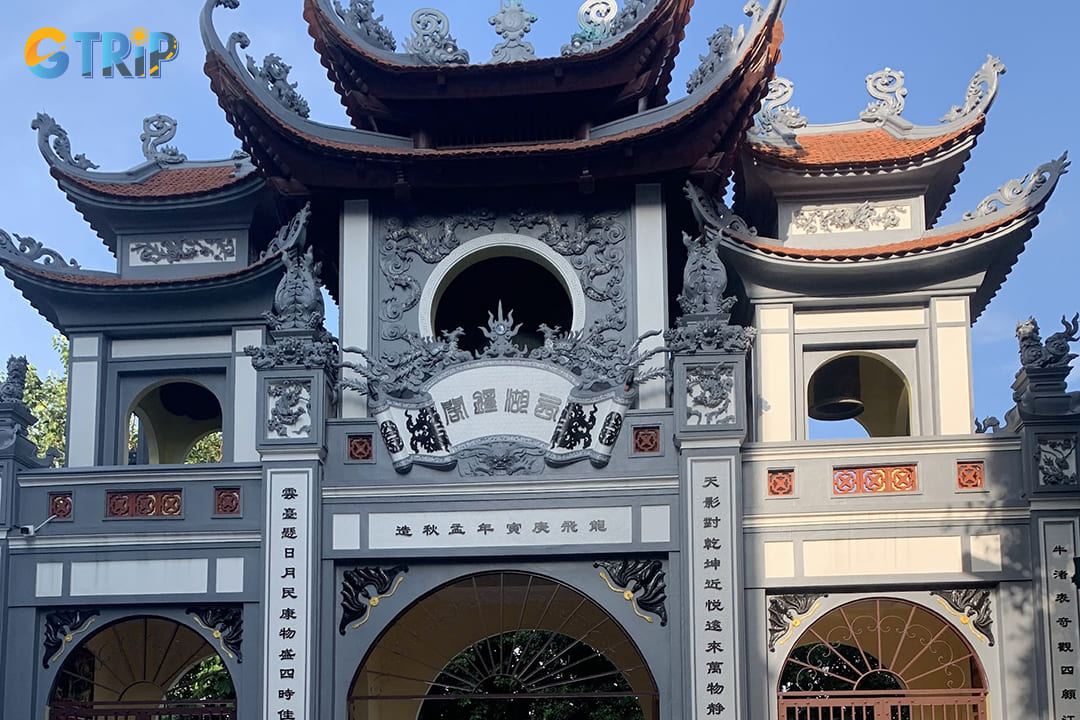
Recognized as one of the most sacred temples in Hanoi, Phu Tay Ho serves as the primary worship center dedicated to the Mother Goddess religion
History of Tay Ho Temple
Officially recognized as a historical and cultural relic in 1996, Tay Ho Temple's origins stretch back several centuries. Most historians believe the temple was initially constructed during the 17th century during Vietnam's Le Dynasty period. The complex has undergone numerous renovations while carefully preserving its distinctive architectural character and spiritual significance. Despite modernization occurring throughout Hanoi, the temple maintains its historical integrity and connection to traditional beliefs.
Tay Ho Temple serves as a major center for Dao Mau, Vietnam's indigenous Mother Goddess worship tradition. This belief system predates the arrival of Buddhism and Confucianism in Vietnam. The temple attracts thousands of pilgrims during major festivals, particularly during the first and fifteenth days of each lunar month. Many devotees visit seeking blessings for health, prosperity, and successful family endeavors. Women especially come to pray for fertility, safe childbirth, and family harmony.
One fascinating cultural legend associated with the temple tells of Vietnamese poet Phung Khac Khoan's encounter with Mother Goddess Lieu Hanh at Tay Ho. According to the story, the renowned scholar met the goddess during his visit and was inspired to compose "Tay Ho Ngu Quan," a poem celebrating the divine feminine presence at the site. This literary connection elevates the temple's cultural significance beyond its religious importance. The tale exemplifies how Tay Ho Temple bridges Vietnam's spiritual traditions with its literary heritage, creating a multifaceted cultural landmark.
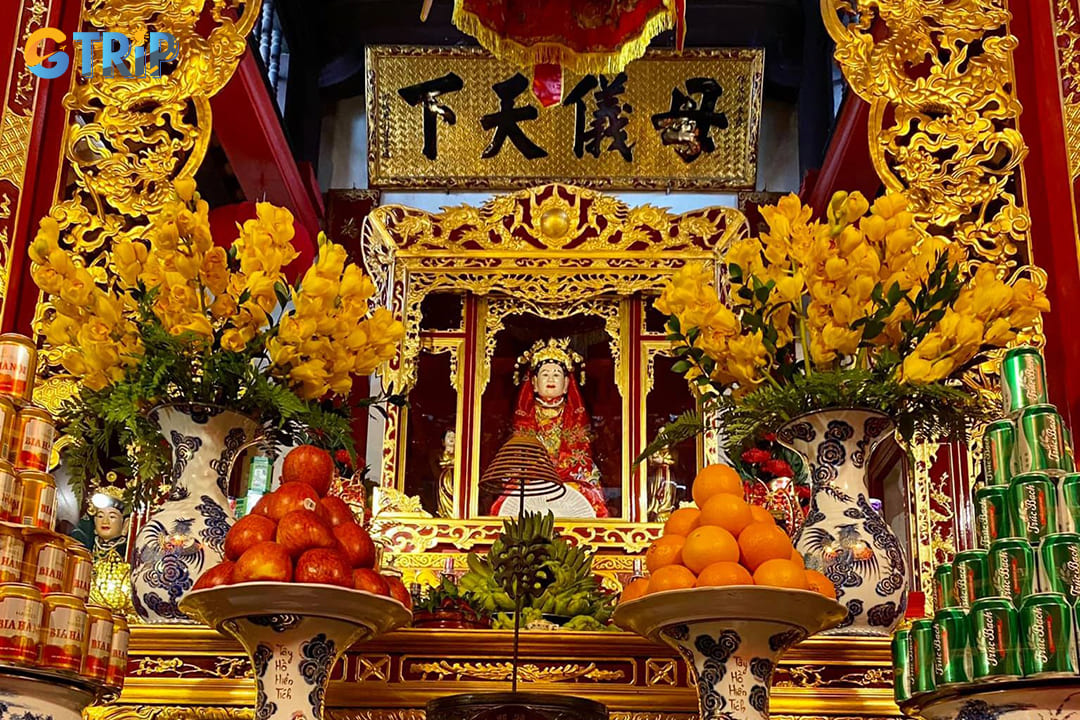
Mother Goddess Lieu Hanh, also known as Princess Quynh Hoa, holds the position of primary deity at Tay Ho Temple
The architecture of Tay Ho Temple
Tay Ho Temple's architectural design represents a masterpiece of traditional Vietnamese religious construction, reflecting both local craftsmanship and spiritual symbolism. The temple complex features multiple structures arranged in a harmonious layout that guides visitors through increasingly sacred spaces.
Three-door Gate (Cong Tam Quan)
The journey through Tay Ho Temple begins at the impressive three-door gate (Cong Tam Quan), a majestic two-story structure that serves as the primary entrance to the sacred grounds. This architectural element follows traditional Vietnamese temple design principles, where the central door is reserved for deities and important dignitaries.
The gate's roof displays the ornate inscription "Phong Dai Nguyet Cac" (Pavilion of Wind and Moon), creating an immediate connection to nature's elements. The gateposts feature elaborately carved poetic couplets that narrate the legendary encounter between the renowned poet Phung Khac Khoan and Mother Goddess Lieu Hanh. They immediately immerse tourists in the temple's mythological significance.
Main Complex
Upon passing through the imposing gate, you enter the spacious temple courtyard dominated by the elegant Phuong Dinh Pavilion. This structure exemplifies classic Fang-style architecture with its distinctive two-tiered eaves and eight-level design that creates a visually striking silhouette against the sky.
The pavilion's wooden construction showcases the refined craftsmanship of traditional Vietnamese carpentry, with intricate detailing in the roof corners, support columns, and decorative elements. This transitional space prepares visitors mentally and spiritually for the more sacred areas that lie beyond, functioning as a buffer between the outside world and the inner sanctum where the deities reside.
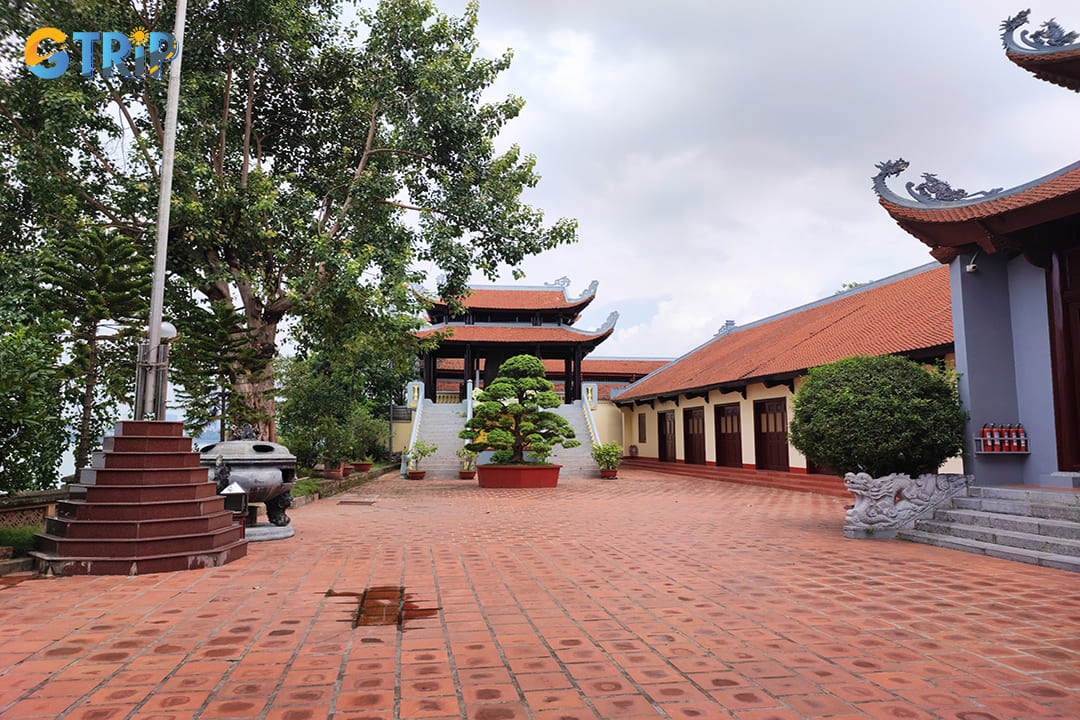
Upon passing through the imposing gate, you enter the spacious temple courtyard dominated by the elegant Phuong Dinh Pavilion
Main Worship Hall
The main palace represents the heart of Tay Ho Temple, beginning with a two-story entrance gate adorned with the Chinese characters "Tay Ho hien tich" (West Lake's sacred traces). Four intricately carved panels decorate the central section, depicting symbolic motifs that carry deep spiritual meaning within Vietnamese folk religion. Behind the Phuong Dinh Pavilion stands the main worship complex, designed in a distinctive "tam" shape that consists of three connected yet distinct layers, each serving specific religious purposes:
First Layer:
- Dedicated to the veneration of the Three Palaces, the Four Palaces of All Spirits, and the Council of Officials
- Features statues of spiritual guardians, Hoang Bay, and Hoang Muoi
- Displays three pairs of parallel sentences praising the virtues and powers of Lord Lieu Hanh
Second Layer:
- Houses altars for the Jade Emperor (supreme deity in Taoist pantheon), Nam Tao (Southern Dipper), and Bac Dau (Northern Dipper)
- Contains poetic parallel sentences celebrating the natural beauty of the West Lake landscape
- Serves as a transitional space between outer worship areas and the inner sanctum
Third Layer:
- Dedicated to the Three Holy Mothers - the most sacred deities in the complex
- Features Mother Thuong Ngan in green (symbolizing forests/wood), Mother Thoai in white (representing water), and Mother Dia in yellow (embodying earth)
- Contains a ceremonial gate with the inscription "Tay Ho Phong Nguyet" (West Lake Wind and Moon)
- Displays the prominent phrase "Mau Nghi Thien Ha" (Mother of All Under Heaven) on the back door roof
The top floor of the back palace contains the most revered statues of Lady Lieu Hanh alongside her companions Chau Quynh and Chau Que. There are the inscriptions "Thien Tien Trac Giang" (Celestial Fairy of the River) and "Mau Nghi Thien Ha" reinforcing her divine status.
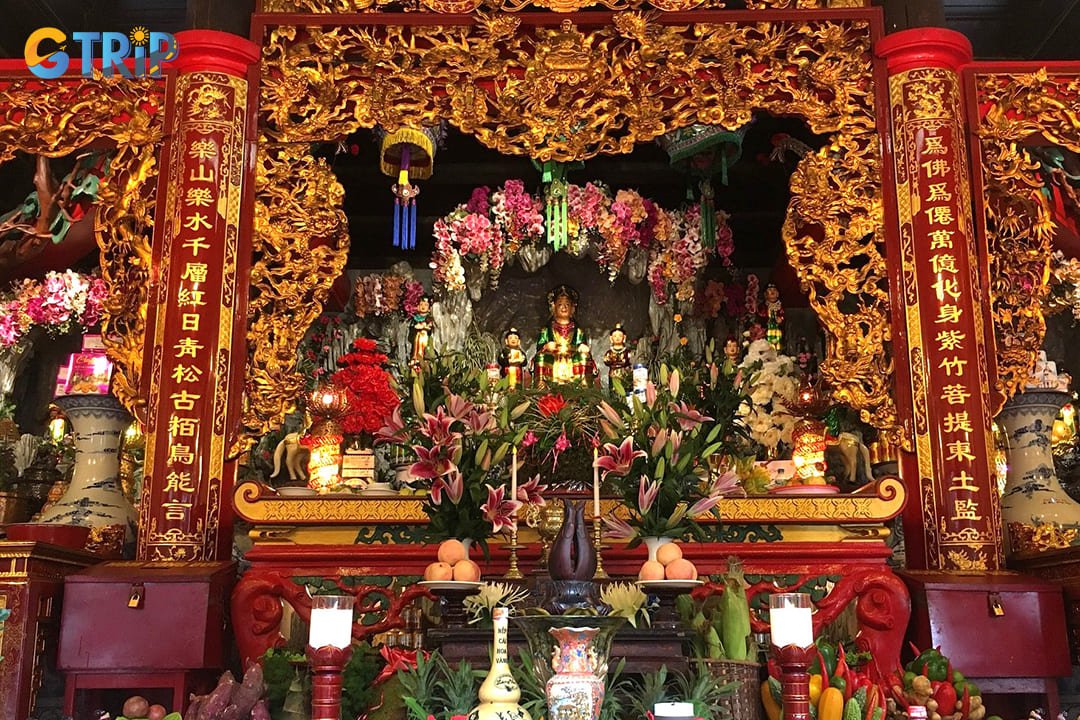
The main palace represents the heart of Tay Ho Temple
Son Trang Shrine
Adjacent to the main worship hall stands the distinctive Son Trang Shrine, an architectural gem featuring three stories and eight gracefully curved eaves. The shrine's design elements incorporate symbolic references to mountain landscapes through its tiered construction and curved rooflines.
Inside this structure, tourists encounter thoughtful spatial arrangements where the floor elevation changes to honor Mother Thuong Thien. The shrine's interior is further divided into three compartments representing sacred caves-symbolic spaces where the boundary between human and divine realms grows thin. This architectural feature references ancient Vietnamese beliefs about caves as portals to spiritual dimensions.
Smaller Shrines
The temple complex extends beyond its main structures to include two smaller yet spiritually significant shrines located in the courtyard. These modest pavilions are dedicated to Co (a young maiden figure) and Cau (a young boy figure). These spiritual entities play crucial roles in local belief systems and ritual practices associated with the Mother Goddess worship tradition.
Near these shrines stands a small tower situated beneath an ancient banyan tree, marking the location of the Tu Chi stele of Vinh Thuan commune. This historical marker was erected in 1845, during the fifth year of Emperor Thieu Tri's reign. It links the temple complex to Vietnam's broader historical timeline and highlights its role as a long-standing center of spiritual and cultural heritage.

The temple complex extends beyond its main structures to include two smaller yet spiritually significant shrines located in the courtyard
5 things to do at Tay Ho Temple
When visiting Phu Tay Ho, tourists can immerse themselves in spiritual activities, cultural appreciation, and scenic enjoyment. This historic temple complex offers numerous experiences that connect travelers with Vietnamese traditions and beliefs while providing opportunities to enjoy the natural beauty of West Lake. Here are the top activities to enhance your visit to this sacred site.
1. Pray and make offerings
The primary purpose of Tay Ho Temple is spiritual devotion, particularly to Mother Lieu Hanh, one of Vietnam's Four Immortals. Tourists from all walks of life come to seek blessings and divine intervention in their daily affairs. The temple's serene atmosphere creates the perfect environment for prayer and contemplation.
To participate in traditional worship practices, purchase incense sticks at the entrance of the temple. Light three incense sticks, hold them between your palms at chest level, and bow three times while making your wishes. Place your offerings-which may include flowers, fruits, or small monetary donations, on the altars dedicated to various deities. Many Vietnamese believe that sincere prayers at Tay Ho Temple bring especially good fortune for business ventures and romantic relationships.
During busy periods like the 1st and 15th days of the lunar month, you'll witness locals performing elaborate rituals. They include burning votive papers (representing material goods in the afterlife) and presenting food offerings. While participating, maintain a respectful demeanor and follow the lead of local worshippers if you're uncertain about proper protocol.
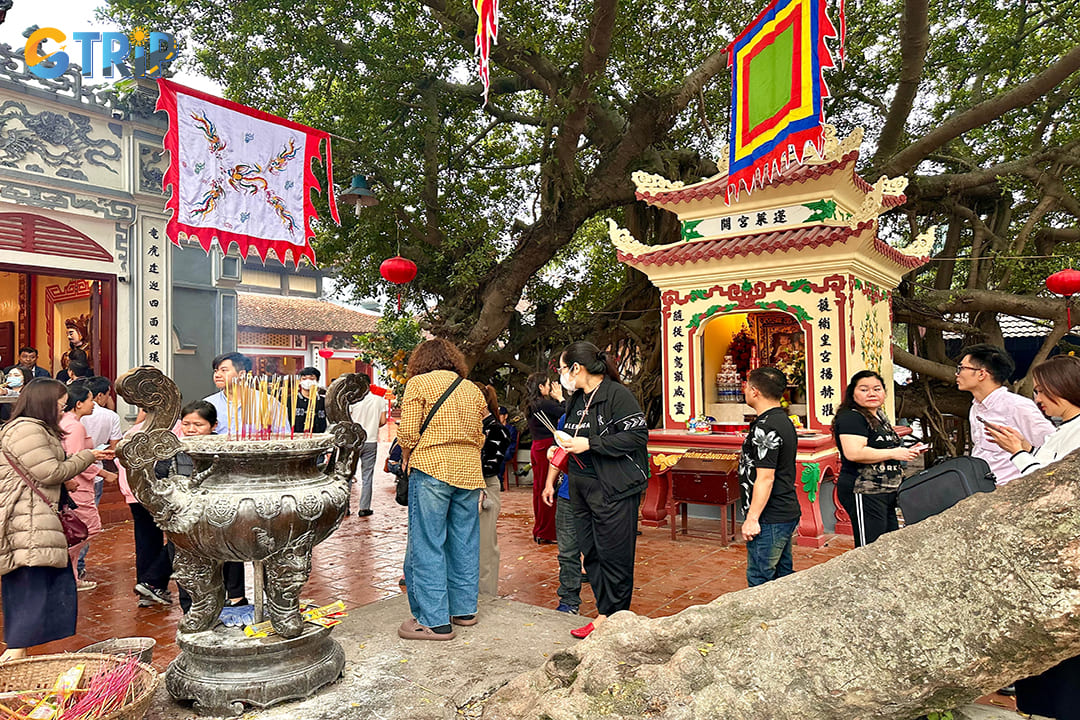
Tourists from all walks of life come to seek blessings and divine intervention in their daily affairs
2. Explore the temple architecture
Tay Ho Temple showcases traditional Vietnamese religious architecture with Chinese influences, making it a fascinating study for architecture enthusiasts and photographers. The complex features several interconnected structures built according to feng shui principles to maximize positive energy flow.
Begin your exploration at the ornate three-door gate (Tam Quan), adorned with intricate woodcarvings depicting dragons, phoenixes, and lotus flowers, symbols of power, rebirth, and purity in Vietnamese culture. The main prayer hall houses beautifully crafted altars with gilded details and vibrant red accents. Take time to admire the curved roof corners with their ceramic decorations that protect against evil spirits.
Behind the main temple stands an ancient Chinese banyan tree said to be several centuries old. Its massive roots and sprawling canopy create a mystical atmosphere, and many visitors touch its trunk for good luck. The lakeside pavilions feature traditional wooden construction techniques with minimal use of nails, demonstrating the skill of Vietnamese craftsmen through the centuries.
3. Attend the Tay Ho Temple festival
Timing your visit to coincide with one of Phu Tay Ho's festivals provides an enriched cultural experience filled with color, music, and tradition. The most significant celebration occurs during the third lunar month (typically March or April in the Gregorian calendar), honoring Mother Lieu Hanh's birthday.
The main festival runs from the 3rd to the 7th day of the third lunar month, featuring elaborate processions where Mother Lieu Hanh's statue is carried around the temple grounds. Participants dress in traditional costumes, creating a vibrant spectacle against the backdrop of West Lake. Incense fills the air as thousands of devotees make offerings at the various shrines throughout the complex.
Cultural performances form the heart of festival activities, with "chau van" singing (a form of spiritual singing) being particularly significant. This hypnotic music accompanies ritualistic spirit possession ceremonies that honor various deities. During the 6th and 7th days of the festival, nearby pagodas host writing contests, traditional instrumental performances, and folk singing competitions.
Regular monthly observances on the 1st and 15th days of each lunar month also bring increased activity to the temple. Tet (Lunar New Year) celebrations draw massive crowds seeking blessings for the coming year. The temple grounds become especially lively during these times, with food vendors, fortune tellers, and calligraphers creating a festive atmosphere.

Timing your visit to coincide with one of Phu Tay Ho's festivals provides an enriched cultural experience filled with color, music, and tradition
4. Take pictures of scenic views
Tay Ho Temple's peninsula location, jutting into West Lake, creates exceptional photography opportunities throughout the day. The temple's picturesque setting combines architectural beauty with natural landscapes, offering different perspectives as the light changes from morning to evening.
Early mornings provide the most tranquil experience, when mist often hovers over the lake's surface, creating ethereal scenes as the temple emerges from the fog. The golden hour before sunset bathes the red and gold temple details in warm light. This is an ideal time for capturing the ornate architectural elements against the backdrop of the shimmering water.
From the temple's lakeside pavilions, photographers can frame panoramic shots of West Lake with the city skyline visible in the distance. The contrast between ancient spiritual structures and modern Hanoi creates compelling visual stories. Consider returning during different seasons to capture varied scenes, lotus flowers in summer, misty landscapes in winter, and festival decorations during celebration periods.
5. Try local food
The area surrounding Tay Ho Temple has developed a reputation for delicious street food specialties that reflect Hanoi's culinary traditions. After completing your temple visit, explore the food stalls and small restaurants that line the approach to the temple complex.
Popular local specialties include:
- Banh tom Ho Tay (West Lake shrimp cakes): A regional specialty featuring sweet potato and fresh shrimp fried to crispy perfection and served with herbs and dipping sauce
- Bun oc (snail noodle soup): A tangy tomato-based soup with rice vermicelli, fresh herbs, and tender river snails
- Che (sweet soups): Various versions of this traditional Vietnamese dessert featuring ingredients like mung beans, black beans, and lotus seeds
Many food vendors have been operating for generations, perfecting family recipes that attract both locals and tourists. Engaging with these small business owners provides insight into daily Vietnamese life and culinary traditions that complement your spiritual experience at the temple.
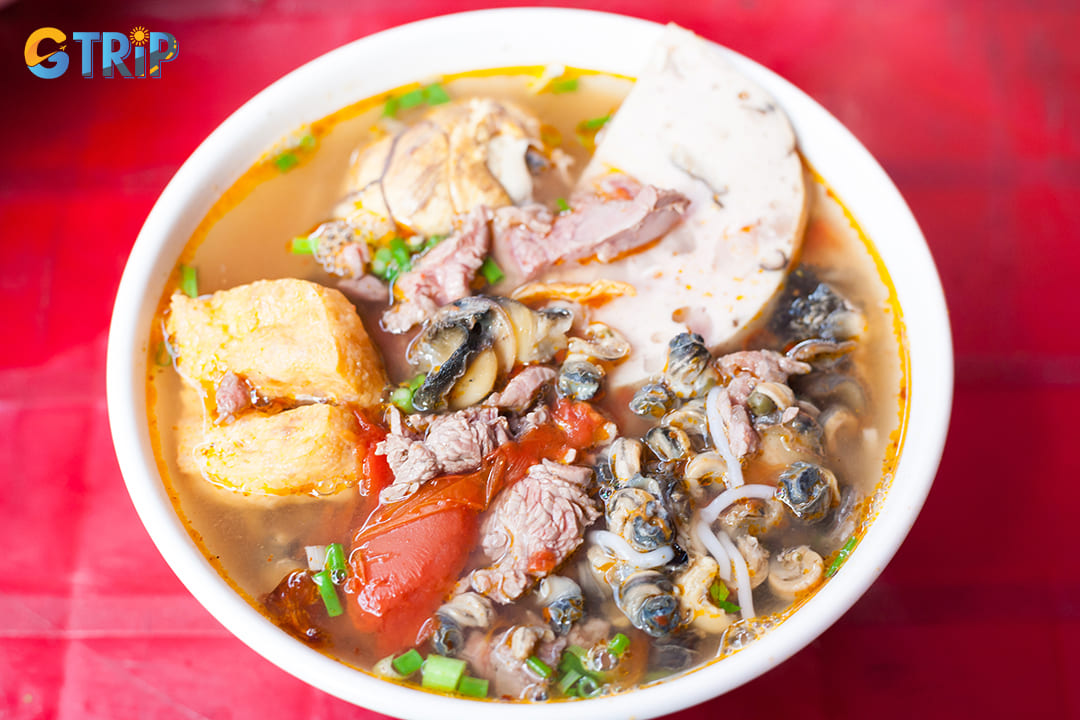
You should try bun oc (snail noodle soup) if you do not want to try a fried dish
Opening hours of Tay Ho Temple
Tay Ho Temple welcomes tourists daily from 5:00 AM to 6:00 PM, offering ample time for both early risers and afternoon explorers to experience its spiritual ambiance. The temple maintains consistent hours throughout the year, ensuring accessibility for travelers planning their West Lake itineraries. During regular days, the temple grounds begin stirring before dawn as locals arrive for morning prayers and offerings.
On special lunar calendar days, the temple extends its visiting hours significantly to accommodate the increased flow of devotees. You can enjoy extended access from 5:00 AM until 9:00 PM on the 1st and 15th days of each lunar month, which are considered particularly auspicious in Vietnamese tradition. These extended hours coincide with heightened spiritual activities, including special prayer ceremonies and larger crowds of worshippers.
The temple observes its most significant visiting periods during two major annual festivals:
- 3rd day of the 3rd lunar month: The spring festival celebrates Mother Goddess Lieu Hanh with elaborate ceremonies
- 13th day of the 8th lunar month: The autumn festival features traditional performances and special offerings
- Tet (Lunar New Year): Extended hours typically apply throughout the holiday period
- Buddha's Birthday: Special ceremonies and extended hours for this important Buddhist celebration
During these festival periods, the temple remains open with extended hours, and visitors can witness colorful processions, traditional performances, and elaborate offerings. The atmosphere becomes particularly vibrant as both locals and tourists gather to participate in the celebrations. For the most authentic experience, consider arriving during the early morning hours when local devotees perform their daily rituals. The temple tends to be less crowded with tourists during these times, allowing for a more contemplative visit. Weekday mornings generally offer the most peaceful atmosphere for those seeking tranquility at Phu Tay Ho.
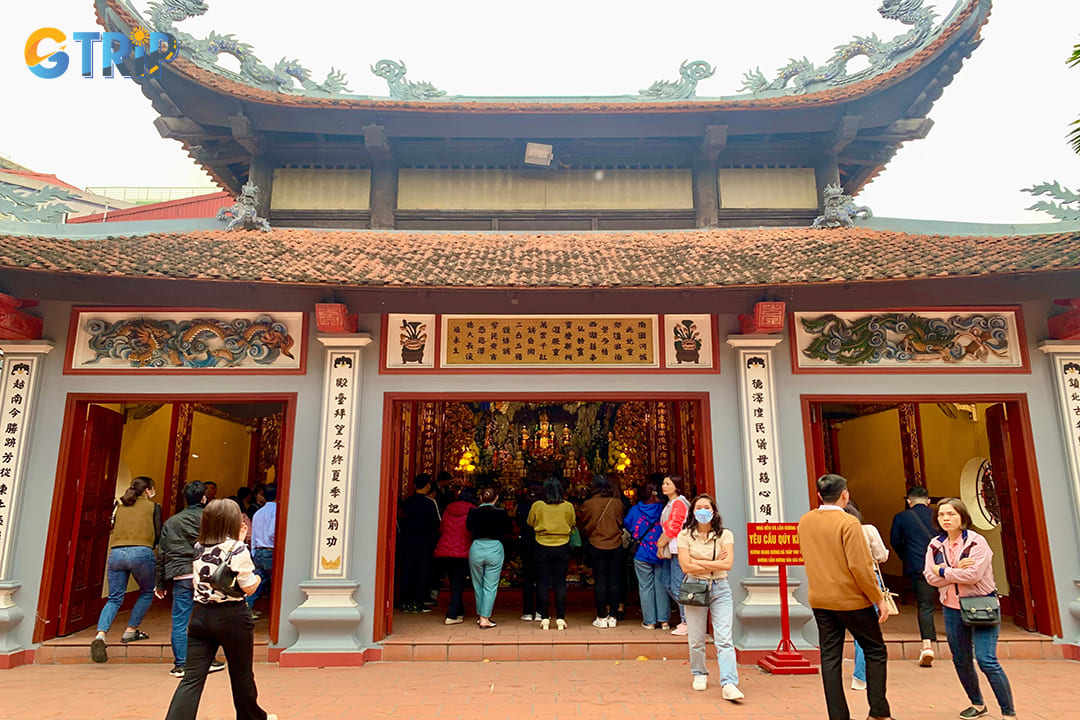
Tay Ho Temple welcomes tourists daily from 5:00 AM to 6:00 PM, offering ample time for both early risers and afternoon explorers to experience its spiritual ambiance
How to get to Tay Ho Temple?
Tay Ho Temple is conveniently located about 4 kilometers from Hanoi's bustling city center, nestled on the eastern shore of West Lake (Ho Tay). Accessing this serene spiritual sanctuary is relatively straightforward, with several transportation options available to suit different preferences and budgets. Below are the main ways to reach this popular destination in the Tay Ho District.
By taxi/ride-hailing services
Taking a taxi or using ride-hailing applications offers the most convenient way to reach Tay Ho Temple, especially for first-time tourists or those with limited time. Most taxi drivers in Hanoi are familiar with "Phu Tay Ho" or "Den Tay Ho", making it a hassle-free journey. The ride from the Old Quarter typically takes 15-20 minutes, depending on traffic conditions. Key ride-hailing options include: Grab, Be, Mai Linh Taxi, G7 Taxi, Xanh SM. The approximate cost ranges from 70,000 to 120,000 VND (3-5 USD) one-way from central Hanoi. During peak hours (7:30 - 9:00 AM and 5:00 - 7:00 PM), expect longer travel times and potentially higher fares.
By bus
The public bus system offers an economical option for reaching Tay Ho Temple, though it requires a bit more navigation and patience.
Three main bus routes connect central Hanoi to the vicinity of Tay Ho Temple:
- Route 31: Operates between Bac Co and Nhat Tan, stopping near the temple entrance
- Route 33: Runs from Long Bien to Cau Dien, with stops within walking distance
- Route 55: Connects Giap Bat Bus Station to Dong Anh, passing close to the temple
Bus fares are extremely affordable at just 7,000-9,000 VND (approximately $0.30-0.40 USD) per journey. Buses typically run from 5:00 AM until around 9:00 PM daily, with frequencies of 10-15 minutes during peak hours and 20-30 minutes during off-peak times. When taking the bus, be prepared for a short 5-10 minute walk from the drop-off point to the temple entrance. This option is ideal for budget travelers or those seeking to experience local transportation.
By motorbike
Renting a motorbike offers flexibility and freedom to explore Tay Ho Temple and the surrounding West Lake area at your own pace. If you're comfortable navigating Hanoi's lively traffic, this option provides an authentic local experience. From the Old Quarter, follow these general directions:
- Head north on Yen Phu Street
- Continue onto Thanh Nien Road (the road dividing West Lake and Truc Bach Lake)
- Follow Au Co Street along the western edge of the lake
- Turn right onto Xuan Dieu Street and continue until you reach the temple entrance
Motorbike rental typically costs 100,000-150,000 VND ($4-7) per day from rental shops in the Old Quarter. Parking is available near the temple for a nominal fee of 10,000 VND ($0.40).
Important safety tips for motorbike travel:
- Always wear a helmet (legally required)
- Drive defensively and follow local traffic patterns
- Use Google Maps with voice navigation
- Have your hotel address written in Vietnamese for the return journey
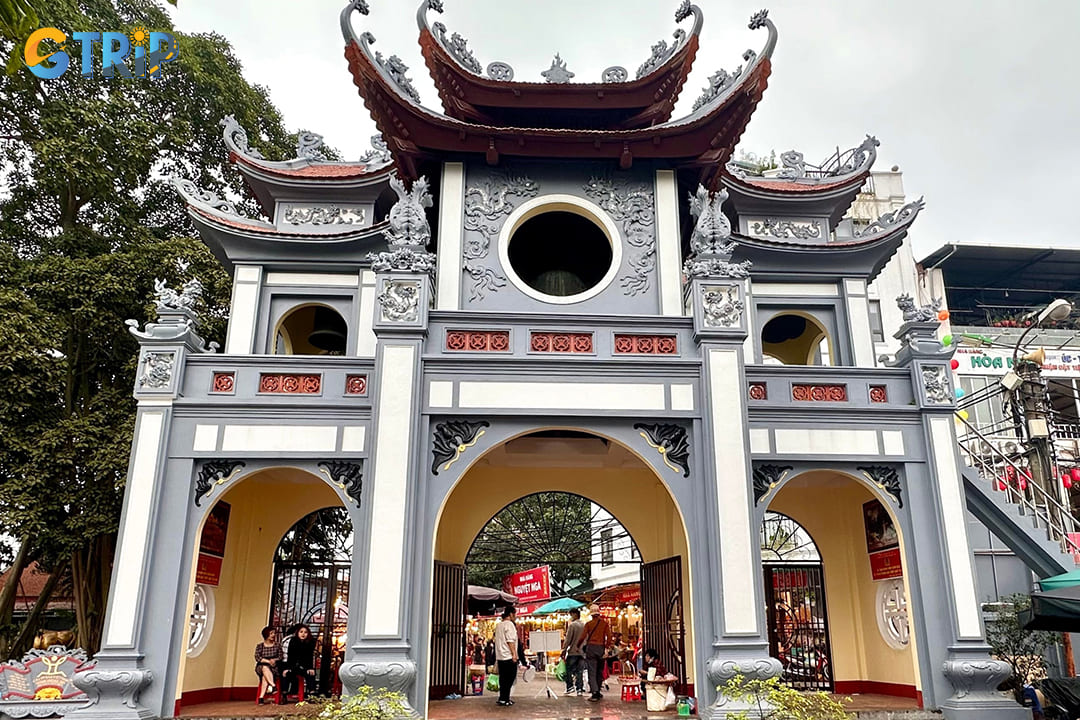
Tay Ho Temple is conveniently located about 4 kilometers from Hanoi's bustling city center, nestled on the eastern shore of West Lake
Important notes when visiting Tay Ho Temple
Make your visit meaningful and respectful by following these simple guidelines.
1. Language and communication
- Most signs are in Vietnamese; download a translation app in advance.
- Basic phrases like "xin chao" (hello) and "cam on" (thank you) are appreciated.
2. Photography tips
- You can take photos in outdoor areas, but not inside the main prayer halls.
- Avoid flash near artifacts or during ceremonies.
- Always ask before photographing worshippers, monks, or nuns.
- Morning light is ideal for photography.
3. Cultural etiquette
- Remove shoes before entering indoor prayer areas.
- Dress modestly, cover shoulders and knees (sarongs may be provided).
- Walk clockwise around altars and sacred items.
- Keep your voices low and avoid pointing at religious icons.
4. Offerings and donations
- Donations are welcome but not required.
- Hold incense at forehead level before placing it; use odd numbers (usually three).
- Place money in designated boxes, not on altars.
5. Cleanliness and respect
- Use trash bins throughout the grounds.
- No smoking, alcohol, or food in worship areas.
- Don’t touch statues or sacred objects.
- Maintain a calm and quiet presence.

Make your visit meaningful and respectful by following these simple guidelines
Nearby attractions from Tay Ho Temple
The area surrounding Tay Ho Temple offers tourists several captivating attractions within walking distance, making it easy to extend your cultural exploration beyond the temple grounds. These nearby sites complement the spiritual experience at Tay Ho Temple and showcase the diverse beauty of Hanoi's Tay Ho District.
West Lake (Ho Tay)
West Lake, or Ho Tay as locals call it, is Hanoi's largest freshwater lake spanning approximately 500 hectares, and serves as the defining geographic feature of the Tay Ho District. The scenic body of water creates a peaceful retreat from Hanoi's bustling streets while offering you multiple ways to experience its charm.
The 17-kilometer shoreline provides an ideal setting for morning or evening walks where you can observe local life unfold. For more active exploration, rent a bicycle from one of the many shops along the lake (prices range from 20,000-50,000 VND per hour) and enjoy the dedicated cycling paths that hug portions of the shoreline.
West Lake's perimeter is dotted with stylish cafes and restaurants, many featuring open-air terraces with unobstructed lake views. Notable spots include The Sunset Bar at the InterContinental Hotel and Summit Lounge, perfect for enjoying Vietnam's famous coffee culture while watching the changing colors reflect off the water's surface.
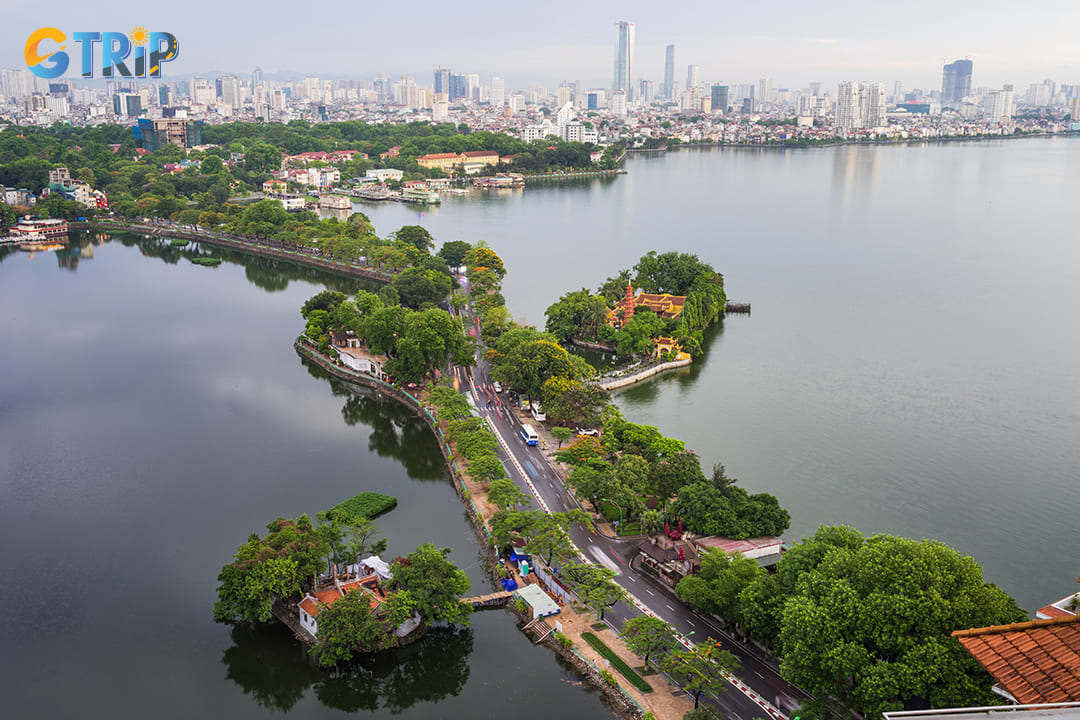
West Lake, or Ho Tay as locals call it, is Hanoi's largest freshwater lake spanning approximately 500 hectares
Pho Linh Pagoda (800 m)
Just 800 meters from Tay Ho Temple stands Pho Linh Pagoda, one of Hanoi's oldest Buddhist temples, dating back to the 12th century during the Ly Dynasty. This historical treasure sits on a small island in West Lake, creating a serene atmosphere enhanced by its waterside setting.
The pagoda complex features several well-preserved structures showcasing traditional Vietnamese Buddhist architecture. The main prayer hall houses an impressive collection of intricately carved wooden statues depicting various Buddhist deities, with the central altar dedicated to Amitabha Buddha. Unlike some more touristic religious sites, Pho Linh maintains an authentic atmosphere where you can often observe monks going about their daily routines and locals coming to pray. Tourists particularly appreciate the pagoda's tranquil courtyard garden with ancient bonsai trees and stone sculptures. The temple is actively used for worship, so remember to dress respectfully with shoulders and knees covered.
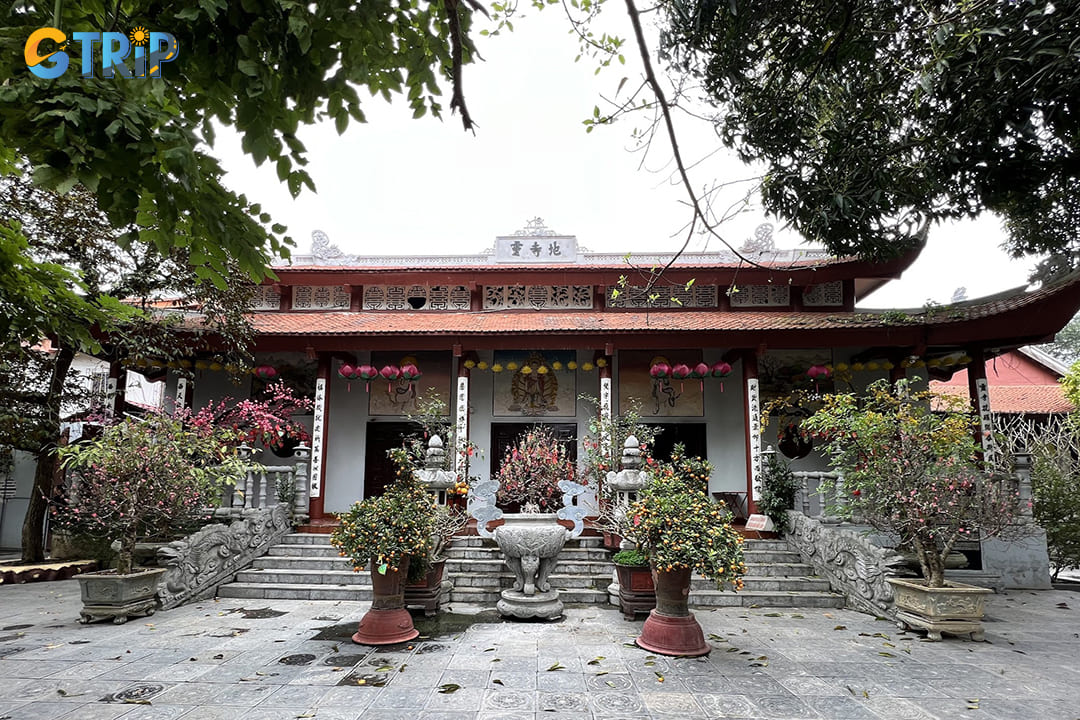
Pho Linh Pagoda sits on a small island in West Lake, creating a serene atmosphere enhanced by its waterside setting
Quang An Garden (260 m)
Located just 260 meters from Tay Ho Temple, Quang An Garden serves as a modern recreational space that perfectly balances exercise opportunities with relaxation zones. This community park has become a favorite among both locals and tourists seeking outdoor activities in a scenic setting.
The garden features:
- Exercise equipment zone
- Modern outdoor fitness machines are suitable for different fitness levels
- Dedicated areas for stretching and bodyweight exercises
- Morning group exercise classes (typically 5:30 - 7:00 AM) where tourists are welcome to join locals
- Relaxation areas
- Shaded pavilions with traditional Vietnamese architectural elements
- Stone benches positioned strategically under mature trees
- Landscaped paths lined with seasonal flowers and ornamental plants
What makes Quang An Garden particularly special is its positioning along the edge of West Lake, offering spectacular views across the water. The garden becomes especially lively during sunset when photographers gather to capture the golden light reflecting off the lake's surface. With its close proximity to Phu Tay Ho, this garden provides the perfect complement to your temple visit-allowing for physical activity and natural beauty to balance the spiritual experience.
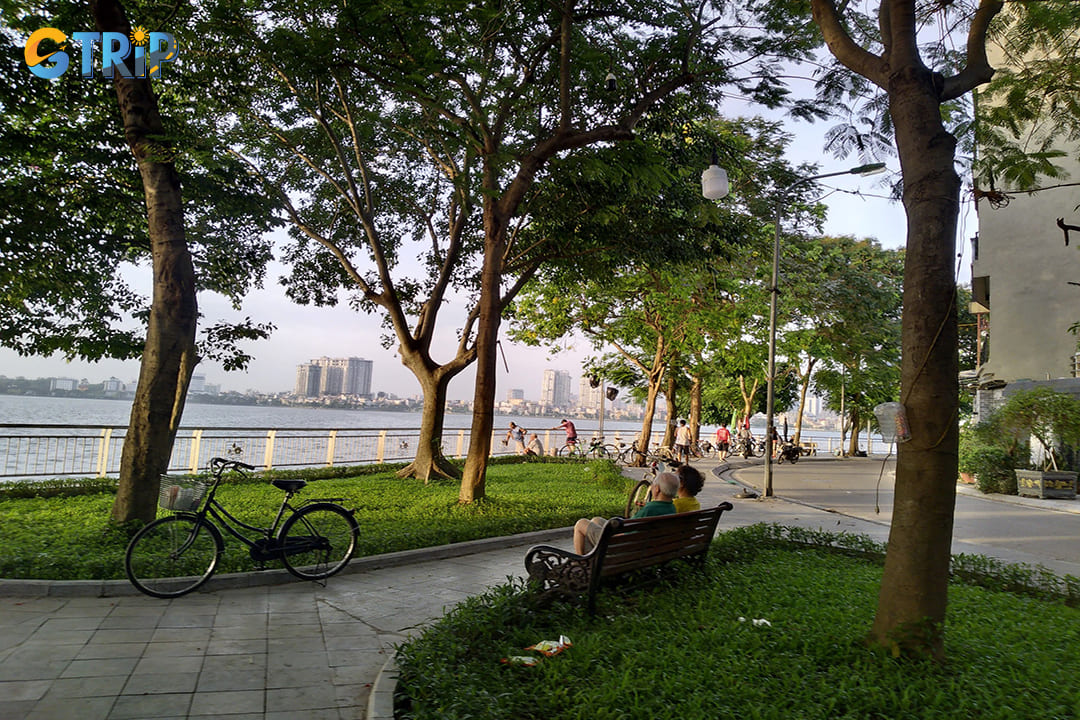
Quang An Garden serves as a modern recreational space that perfectly balances exercise opportunities with relaxation zones
Visiting Tay Ho Temple offers more than just a glimpse into Vietnam's spiritual heritage. It's a chance to immerse yourself in the serene beauty and cultural richness of Hanoi. As you stroll through its tranquil grounds, feel the calming energy that invites reflection and peace. The temple stands as a testament to centuries-old traditions, allowing visitors an authentic connection with local customs. Your exploration of Phu Tay Ho leaves you not just with cherished memories but also a deeper appreciation of Vietnamese culture. If you are interested in this temple or any other attractions in Hanoi, consider booking curated Hanoi Tours of GTrip - Vietnam Travel Agency.

